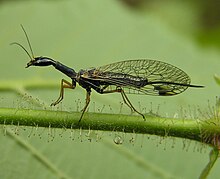Snakefly
Appearance
| Snakefly Temporal range: Lower Jurassic – Recent
| |
|---|---|

| |
| Female Dichrostigma flavipes | |
| Scientific classification | |
| Kingdom: | |
| Phylum: | |
| Class: | |
| Infraclass: | |
| Order: | Raphidioptera Handlirsch, 1908
|
| Synonyms | |
| |
The Snakeflies (Raphidioptera) are a small order of Endopterygote insects. They are closely related to the Megaloptera and Neuroptera.[1]
There are about 210 living species. They are easily recognized by their small head and long 'neck', which is actually the elongated prothorax.
The snakefly, about 15 mm (0.6 inch) long, has two pairs of similar, net-veined wings, long antennae, and chewing mouthparts. The female lays eggs with a long ovipositor.
Life cycle
[change | change source]The life cycle includes egg, larva, pupa, and adult. The active and carnivorous larvae live beneath loose tree bark. The snakefly is found on every continent except Australia and may be beneficial to humans because it destroys the larvae and pupae of other insects.[2]
References
[change | change source]- ↑ Jepson, J.E.; Jarzembowski, E.A. (2008). "Two new species of snakefly (Insecta:Raphidioptera) from the Lower Cretaceous of England and Spain with a review of other fossil raphidiopterans from the Jurassic/Cretaceous transition" (PDF). Alavesia. 2: 193–201. Archived from the original (PDF) on 2011-07-18. Retrieved 2011-06-10.
- ↑ Aspöck, H. 2002. The biology of Raphidioptera: a review of present knowledge. Acta Zoologica Academiae Scientiarum Hungaricae. 48 (Supplement 2): 35–50. PDF fulltext
